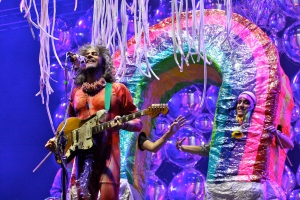 One month since Japan’s Mt. Ontake eruption killed 57, I spoke with Columbia volcanologist Philipp Ruprecht for NTV about what has been learned and why so many had to die.
One month since Japan’s Mt. Ontake eruption killed 57, I spoke with Columbia volcanologist Philipp Ruprecht for NTV about what has been learned and why so many had to die.
Monthly Archives: October 2014
The Love Behind Anime: Patrick Galbraith’s “The Moé Manifesto”
When it comes to Japan’s image in the global eye, kawaii—the “cute-ification” of just about everyone and everything—is a staple. However, lesser known is moe, an emphasis on the emotional response to fictional characters, as opposed to the characters themselves.
The moe phenomenon has been misrepresented and stigmatized as bizarre overseas. But Patrick Galbraith, author of The Moé Manifesto, the world’s first English book on the attraction, sets the record straight.
“Moe—which is the noun form of the verb moeru (which can mean ‘to sprout’ or ‘to burn’)—is a response to fictional characters,” explains the American author. “It has the connotation of something that gets your motor running.”
“There’s a lot of misunderstanding,” he says regarding fans of manga, anime and game. “It’s easy to look at images of Japanese men embracing pillows with their favorite characters and say, ‘Man, those guys are weird!’ It’s a joke; we laugh and move on.”
“The Moé Manifesto is an attempt to talk with people on the inside—creators, fans and critics of manga, anime and games in Japan—and get their perspective. It’s a manifesto in the sense that it’s a political statement: let’s take people and their lives seriously. Rather than point, laugh and dismiss, let’s listen to them and respect that we might not understand it immediately.”
The moe style is characterized by exaggerated features, such as unnaturally huge eyes and nonexistent mouths and noses. First used in girls’s comics, these elements were introduced to emphasize characters’s emotional responses, and were later adopted in men’s manga and anime, through which they became a standard.
“One interesting result is … ‘anti-realism.’ Cute girl characters don’t exactly look like real women. You can have characters that are attractive without any comparison to or connection to the ‘real’ thing.”
But exactly how important is sexual fantasy to moe? “I posed that question to Honda Toru,” Galbraith says of the moe guru. “He married a character from a PC game. He was attracted to her sexually, sure, but there’s something more to it. Honda describes that ‘something more’ as love.”
What surprised the author, though, was how robust the discourse on moe is in Japan. “Many of us can regonize the allure of comic book and cartoon characters, but how often do you hear people talk about marrying them—and what that might mean socially and economically? Or advocating [a] sexual orientation toward fictional characters?
“What surprised me most was how serious people took their relationships with fictional characters, which were described to me as life-saving—a reason for living, or an alternative way of life.”
Metropolis, issue 1073
Fuji Rock Festival 2014: Still an unmatched feast of sounds
Fuji Rock turned 18 this year, an age when newly minted adults are able to drink and drive in many countries.
Promoter Smash marked Fuji’s coming of age quietly. Japan’s marquee rock festival isn’t the rapidly growing sprout of its early years. Instead, like its model Glastonbury, Fuji Rock has reached a stage of maturity where few surprises are expected, but it can still be trusted to deliver an unmatched feast of sounds—and offer a snapshot into the state of international music in Japan.
For some perspective consider the following: when Fuji began in 1997, this year’s headliners, Canada’s ambitious Arcade Fire were still fresh-faced teenagers. Late-breaking New Zealand songstress Lorde was an eight-month-old infant.
With Japan’s youth population in a tailspin, Smash has had to cultivate the loyalty of its aging rock demographic. This it’s done in style by building its kids area into a memorable Tarzan-adventure treat (disclosure: I attended with son in tow for the first time).
The quoted attendance of 102,000 over three days was down a bit from peak years, but among the revelers was a growing contingent of families. Cultivating a multigenerational audience—long a goal of Smash boss Masa Hidaka—and attracting more folks from overseas (Chinese accents were heard frequently this year), look to be the key to maintaining Fuji’s run of success.
The larger problem of whether rock itself is facing senescence is something festivals everywhere are grappling with. Fuji’s stabs at broadening its audience into the hip-hop market have yielded acts from Run DMC to Eminem. Kanye West was supposed to headline the 2014 edition but for unexplained reasons canceled, leaving a reunited Outkast to wave the banner.
In the meantime Smash can only hope that emerging lights such as deep-lunged Lorde and indie rock fairy princess St. Vincent—this writer’s best act of 2014—will one day be big enough to fill the Naeba Ski Resort’s gigantic Green Stage with a new generation of rock fans. With stadium-level classic rock, punk and even grunge-era rock bands in increasingly short supply and international music’s market share in Japan stagnant, Fuji Rock may look different in the future.
In addition to fighting to maintain international rock’s appeal in Japan, we’d also like to see Smash do a better job of alerting Japanese to their own emerging rock music. Toward this end we think it’s possible to achieve a more creatively curated selection of young domestic acts for the Rookie A Go-Go stage. This stage has been the launchpad for acts like Sambomaster, but for the most part doesn’t seem to host many of the intriguing bands on Japan’s underground live house circuit.
What isn’t in doubt about Fuji Rock is the promise of a rewarding and diverse weekend of music, performance, freak shows, mountain breezes, and a uniquely freewheeling break from Japan’s grueling day-to-day. It’s the last factor that more than anything else guarantees the festival’s future for many years to come.


